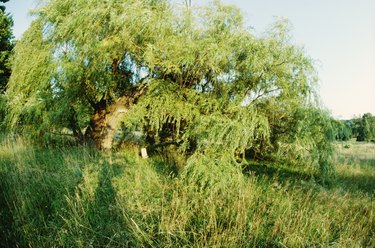Things You'll Need
Saw
Herbicide
Paintbrush or sprayer

Willow trees (Salix spp.) are often prized specimens in landscapes and natural settings, especially near water features, for their graceful form and an ability to thrive in poorly drained soils. Willow trees are also known for their prolific root systems, which can penetrate leach fields, lift sidewalks and otherwise damage structures and interfere with yard maintenance. Whether the willow's roots are creating problems or the tree is diseased or dying, it should be removed In this case, the stump and roots must also be treated to prevent re-sprouting.
Step 1
Remove the tree. Cut off as much of the surface as possible if the stump has been sitting for longer than a few hours since removal. If the top few inches of stump cannot be easily removed, fray the bark to expose more of the tree's phloem. Ideally, the herbicide should be applied within 10 minutes of this cutting.
Video of the Day
Step 2
Select and prepare a herbicide. For willow stump treatment, use a herbicide that contains dicamba, triclopyr, imazapyr or picloram and 2,4-D. Glyphosate- and 2,4-D-based herbicides can be used for fair control, but stumps will then likely require further treatments.
Step 3
Apply the herbicide to the cut surface according to manufacturer's instructions. One possible appliation method could involve brushing a thorough layer of herbicide on the cut and frayed surface. The chemical can also be sprayed onto the exposed surface.
Tip
Herbicide treatments are most effective if the tree is not under moisture stress. Avoid applying herbicides during the spring when there is heavy upward sap flow. Fall applications are often most effective, as the tree is building energy reserves in the root system. Water-soluble herbicides may prove more effective than esters.
Video of the Day